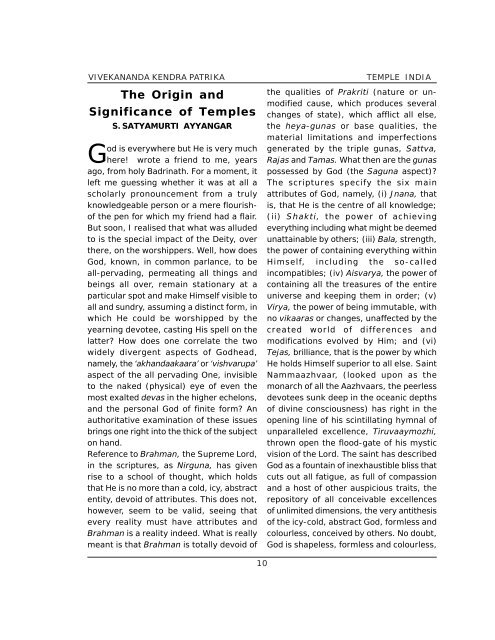Temples In India-1.pdf - Vivekananda Kendra Prakashan
Temples In India-1.pdf - Vivekananda Kendra Prakashan
Temples In India-1.pdf - Vivekananda Kendra Prakashan
Create successful ePaper yourself
Turn your PDF publications into a flip-book with our unique Google optimized e-Paper software.
VIVEKANANDA KENDRA PATRIKAThe Origin andSignificance of <strong>Temples</strong>S. SATYAMURTI AYYANGARGod is everywhere but He is very muchhere! wrote a friend to me, yearsago, from holy Badrinath. For a moment, itleft me guessing whether it was at all ascholarly pronouncement from a trulyknowledgeable person or a mere flourishofthe pen for which my friend had a flair.But soon, I realised that what was alludedto is the special impact of the Deity, overthere, on the worshippers. Well, how doesGod, known, in common parlance, to beall-pervading, permeating all things andbeings all over, remain stationary at aparticular spot and make Himself visible toall and sundry, assuming a distinct form, inwhich He could be worshipped by theyearning devotee, casting His spell on thelatter? How does one correlate the twowidely divergent aspects of Godhead,namely, the ‘akhandaakaara’ or ‘vishvarupa’aspect of the all pervading One, invisibleto the naked (physical) eye of even themost exalted devas in the higher echelons,and the personal God of finite form? Anauthoritative examination of these issuesbrings one right into the thick of the subjecton hand.Reference to Brahman, the Supreme Lord,in the scriptures, as Nirguna, has givenrise to a school of thought, which holdsthat He is no more than a cold, icy, abstractentity, devoid of attributes. This does not,however, seem to be valid, seeing thatevery reality must have attributes andBrahman is a reality indeed. What is reallymeant is that Brahman is totally devoid ofTEMPLE INDIAthe qualities of Prakriti (nature or unmodifiedcause, which produces severalchanges of state), which afflict all else,the heya-gunas or base qualities, thematerial limitations and imperfectionsgenerated by the triple gunas, Sattva,Rajas and Tamas. What then are the gunaspossessed by God (the Saguna aspect)?The scriptures specify the six mainattributes of God, namely, (i) Jnana, thatis, that He is the centre of all knowledge;(ii) Shakti, the power of achievingeverything including what might be deemedunattainable by others; (iii) Bala, strength,the power of containing everything withinHimself, including the so-calledincompatibles; (iv) Aisvarya, the power ofcontaining all the treasures of the entireuniverse and keeping them in order; (v)Virya, the power of being immutable, withno vikaaras or changes, unaffected by thecreated world of differences andmodifications evolved by Him; and (vi)Tejas, brilliance, that is the power by whichHe holds Himself superior to all else. SaintNammaazhvaar, (looked upon as themonarch of all the Aazhvaars, the peerlessdevotees sunk deep in the oceanic depthsof divine consciousness) has right in theopening line of his scintillating hymnal ofunparalleled excellence, Tiruvaaymozhi,thrown open the flood-gate of his mysticvision of the Lord. The saint has describedGod as a fountain of inexhaustible bliss thatcuts out all fatigue, as full of compassionand a host of other auspicious traits, therepository of all conceivable excellencesof unlimited dimensions, the very antithesisof the icy-cold, abstract God, formless andcolourless, conceived by others. No doubt,God is shapeless, formless and colourless,10
















